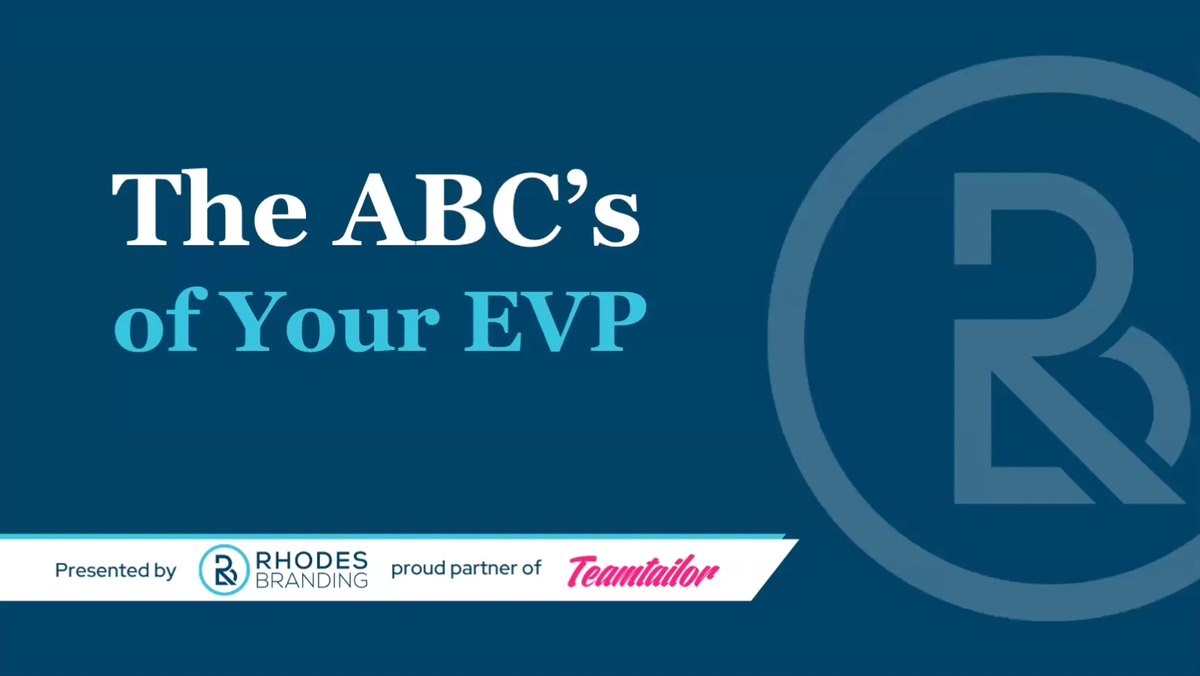How to Enhance Your School Employer Brand with a Powerful EVP: A Guide from Teamtailor and Rhodes Branding

In this article, Rhodes Branding, proud partner of Teamtailor, will explore the essential components of a successful Employee Value Proposition (EVP) —advancement, balance, culture, data-driven decisions, equity, and flexibility—along with practical examples and best practices from various sectors. Practical implications are shown to help schools attract talent, hire faster, and improve employee retention!

Molly McGowan Gorsuch, APR
Molly McGowan Gorsuch, APR, is the Director of Client Engagement at Rhodes Branding and guest author for Teamtailor's Content Hub!
In today's competitive education landscape, a school district's brand is not just about its reputation among students and parents; it's also crucial in attracting and retaining top-tier talent. With the evolving expectations of job seekers and the increasing importance of a supportive work environment, districts need to clearly communicate their Employee Value Proposition (EVP). Your EVP is a fundamental element of a job seeker's journey, influencing their decision to join and stay with your district.
A district’s brand has the power to elevate perception across the board, ensuring schools remain culturally relevant to their target audiences (both current and prospective teachers/staff, as well as parents, students and the business communities). And your Employee Value Proposition is a key touchpoint in the job seeker’s and candidate��’s journey with your district.
The ABCs of Your EVP

Let’s break down the ABC’s of a successful EVP, and a few real-world best practices from across sectors.
A is for Advancement (in one’s career)
As individuals progress through their careers, it’s natural for them to seek out new opportunities to grow professionally. Smart companies and organizations facilitate opportunities so great employees want to grow with the company - instead of seeking out new ventures. This plays directly into teacher and employee retention - so showcase what you can offer candidates early! Don’t wait until after they’re in the system to tell them about professional development opportunities.
Results from a study by O.C. Tanner Institute on workplace culture trends in 2024 indicate employees are at least 2x more likely to feel belonging, inclusion, and a sense of community when companies provide:
- Reimbursement for professional classes directly applicable to work
- Tuition reimbursement programs
- Time during work to complete training.
See what this can look like in a K-12 setting.
B is for Balance
Work-life balance can be described as being able to compartmentalize job tasks and life - to disconnect and switch off without guilt from work. Removing that “guilt factor” is something that can be accomplished by making tweaks like tech conglomerate CISCO did to recruit and retain the older workforce.
The networking and IT brand added “grandternity leave” to its EVP, providing paid time off for new grandparents to spend time with their new grandchildren and provide support to families. This is also a great example of a Data-Driven decision; CISCO looked at their current workforce to make changes that would attract this audience because 30% of their benefits-eligible workforce in the U.S. were 50 or older, and the “75 and older” segment of the labor force is expected to nearly double over the next decade.
In the K-12 field - especially for teachers - the complexity of the job doesn’t lend itself well to balance. Through the lens of a teacher’s day: it’s not just showing up to teach, it’s lesson planning outside the classroom, arriving early for car rider line duty, staying late to man the concession stand for a home game, etc. And school building administrators practically live at school. Add the perception of “on call” availability thanks to technology, and balance can seem like a pipe dream to educators.
But it doesn’t have to be that way, if frameworks are in place and expectations are clearly communicated. Check out tips on how administrators can promote balance in their EVP.
C is for Culture
Organizational culture is seen in the way people interact with each other, in decision-making, and in the values they hold. If your district’s culture shines through to prospective candidates, they can see what the employee experience is like, and how they will (or won’t) fit in. A couple of districts that understand the role of culture in attracting and retaining high-caliber employees are Glenview Public Schools District 34 in Illinois and Hemlock Public School District in Michigan.
Wellness is a key element of the culture at Glenview District 34. Through #BeWell34, a campaign launched at the height of the COVID-19 pandemic, they’ve become known for employee and family well-being. Now a prominent tool on Glenview’s website, the #BeWell34 portal connects staff, students, and families to resources and activities for physical, emotional, and mental wellness. Cathy Kedjidjian, director of communications and strategic planning, said in a National Association of School Boards article, “(It’s) become its own connector to our staff … a way for educators to communicate and connect, and in turn that helps our culture of caring and culture of wellness that is important to our entire district.”
D is for Data-Driven
While there are trends and similarities across districts and regions, your district’s specific candidate and workforce data should inform recruitment and retention strategies - which are reflected in the Employee Value Proposition. This can include:
- Generations in workforce / generational drivers: Knowing which generation(s) represent the majority of your current and incoming workforce, and analyzing their drivers.
- Qualified candidate sources: Knowing where the majority of your qualified candidates - and more importantly, hired candidates - are coming from.
- Qualitative data from recent hires and veteran employees: Gathering feedback from listening sessions with recent hires to learn about their motivations for applying and uncover pain points in the onboarding process; analyzing areas where your district shines in providing support (like peer mentor matching) that can be more prominent in the EVP and recruitment marketing materials; collecting insights from longstanding employees to improve retention strategies.
- Average years of service before departure: Knowing how long an employee typically works with you before either retiring or leaving to inform how you encourage growth and celebrate longevity at career milestones.
USAA understands the importance of encouraging growth and celebrating longevity, so the financial services company holds annual luncheons to honor those who’ve been with them for more than 25 years (which is 10% of their staff).
Most schools have retirement events for employees, but don’t wait until they’re ending their careers to celebrate them. Dig into the data to see what the average number of years your teachers work for you before retirement, then determine a midpoint year to recognize staff commitment to the system. Make them want to finish out their career with you.
E is for Equity
Gallup defines equity as fair treatment, access, and advancement for each person in an organization. And there’s a difference between equality and equity - while equality is making sure everyone gets the same access to the same resources - think all the things a new hire gets when onboarding - equity is about meeting specific, individual needs. Just like educators should “meet students where they are” to help them succeed academically, K-12 employers must “meet educators and staff where they are” to help them succeed in their careers and promote an equitable workplace.
What that looks like:
- Everyone can come to work in a place that embraces creative tension and permits meaningful debate
- Administrators regularly seek feedback on leadership effectiveness and welcome honest two-way dialogue.
- Responsive skill-building opportunities are available to all employees, who are given the autonomy and support to grasp them.
F is for Flexibility
According to a recent McKinsey & Co study, flexibility is ranked highly across the board among all generations in the current workforce as a motivating factor to stay in a current job. It’s the top reason among Gen Z, Younger, and Older millennials, which is important for employers to consider since these groups will be making up the majority of the job-seekers in the next couple of years.
Flexibility not only includes things like allowing time for personal matters and professional development, but also autonomy in how employees accomplish their work. Districts can provide flexibility around how employees do their work and build skills. “We want to honor intellectual freedom and intellectual capacity within the district,” Dr. Kevin McGowan, superintendent of Brighton Central Schools in Rochester, N.Y. says. ““The same life circumstances we’re asking (staff) to accommodate, with people that they are serving, they have in their own life - likely as parents and caregivers themselves.”
See what else Dr. McGowan had to say about flexibility on the Rhodes Branding podcast.
Another great K-12 example of providing flexibility comes from McKinney Independent School District in Texas. Chief Human Resource Officer Dr. Chad Teague said the district was losing their Occupational therapists, physical therapists, and student language pathologists to neighboring districts that had started implementing this level of flexibility. To remain competitive, they adopted a similar remote work policy for OT, PT, and SLP roles in July 2023 – and rebuilt their candidate pool.
So to recap:
A is for Advancement (in one’s career), B is for Balance, C is for Culture, D is for Data-Driven, E is for Equity, and F is for Flexibility. If you can sing through these and know they’re in your EVP, you’re sure to attract (and retain) qualified employees to your district!
By embracing and implementing the ABCs of a successful EVP—Advancement, Balance, Culture, Data-Driven decisions, Equity, and Flexibility—your district can create a compelling narrative that resonates with prospective candidates. These elements not only enhance your district's appeal but also foster a supportive and dynamic work environment that retains talent. Remember, a well-crafted EVP is more than just a set of promises; it's a reflection of your district's commitment to its employees' growth, well-being, and success.
This collaborative effort between Teamtailor and Rhodes Branding is dedicated to helping schools attract and hire qualified, dedicated professionals faster. By focusing on these key areas, you can build a thriving educational community that stands out in the competitive landscape.
Our partners at Rhodes Branding
Molly McGowan Gorsuch, APR

As Director of Client Engagement for Rhodes Branding, Molly is the liaison between education leaders and the agency, connecting the K-12 community with services designed to accelerate performance and market position. She leads content and partner engagement strategy, and is a frequent conference presenter and podcast/blog guest. She also supports the onboarding of new clients, business development strategy, awareness, and marketing communications efforts for Rhodes Branding’s growth initiatives.
![]()
What is an Employee Value Proposition (EVP)?
Your Employee Value Proposition (EVP) is a tool to boost your employer brand and retention rate. Learn how your EVP can help your organisation.
![]()
How to create an effective career site
We’ve built a comprehensive guide that will help you transform your career site into one that converts the right talent. Here are some key takeaways.
![]()
How to measure your employer brand
Candidates’ priorities are changing, so your employer brand should adapt to these changes. We’ve listed key metrics to measure your employer brand.


